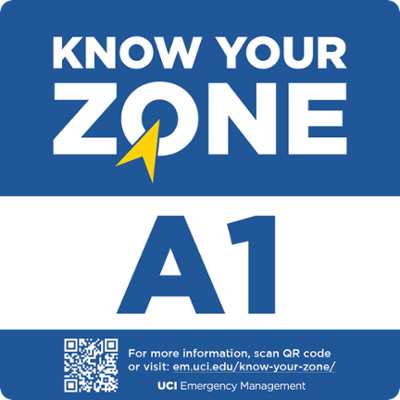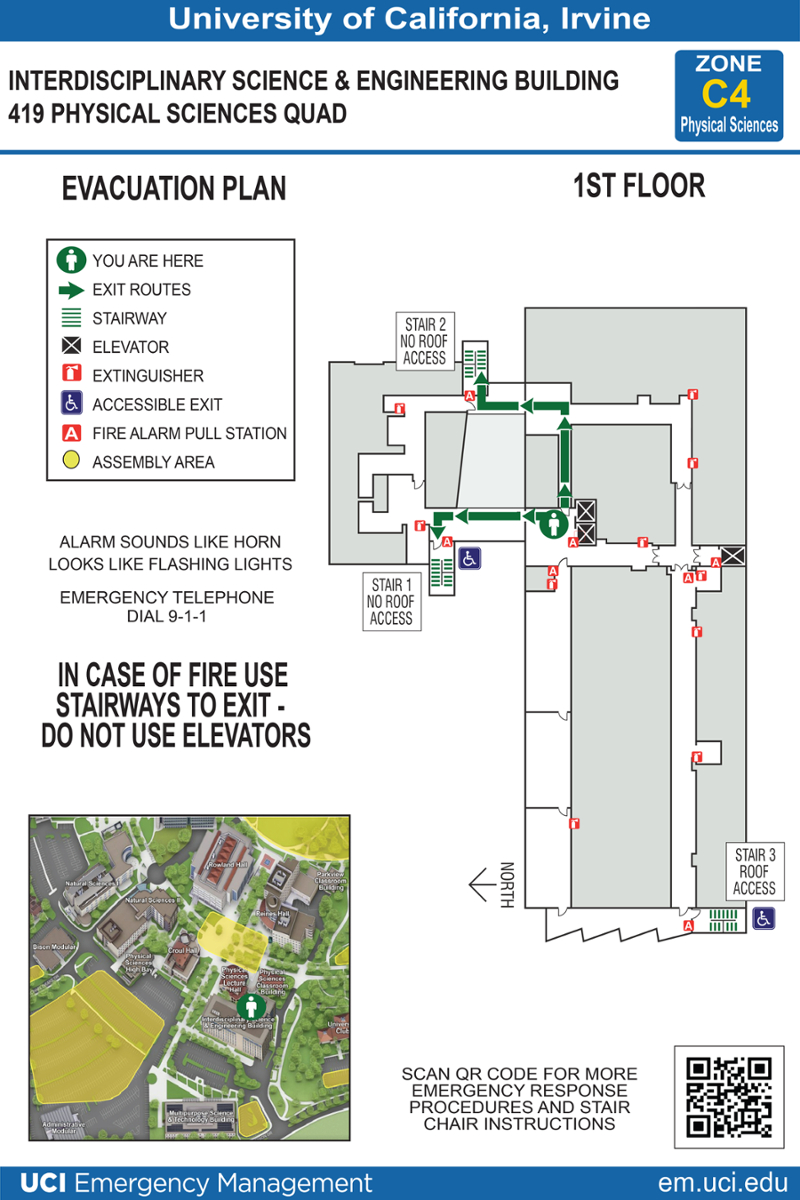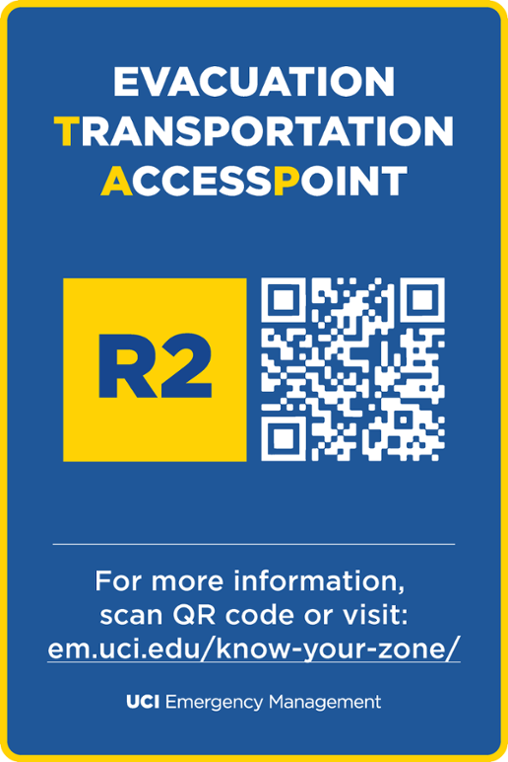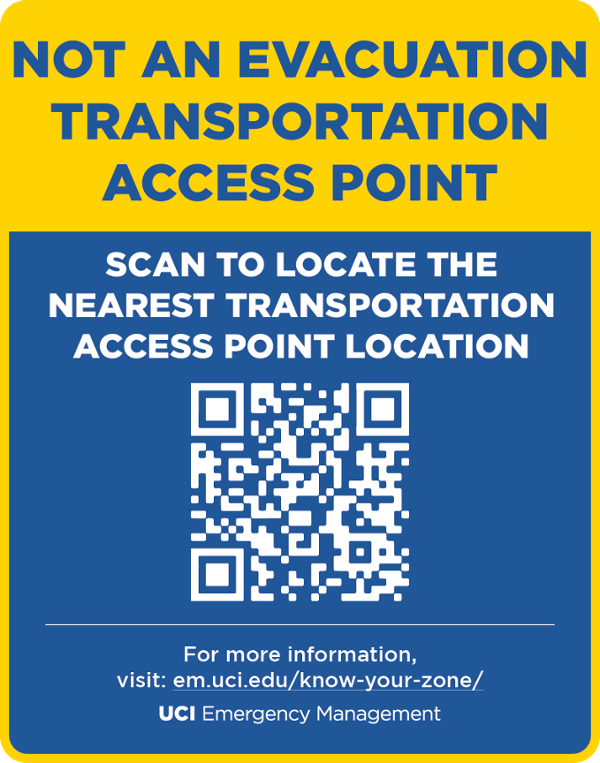Know Your Zone

UCI has developed an evacuation zone map to help the campus community understand their evacuation zone in the event of an emergency. During the response phase of a disaster, UCI Police Department (UCIPD) and/or Orange County Fire Authority (OCFA) will assess the need to initiate evacuation procedures. In the event an evacuation is required, it’s critical for the UCI campus community to be familiar with these zones and review this page for additional resources available to assist with evacuating during an incident. Click on the map to see what zone you are located in.
Evacuation Signage
During emergencies, evacuations will be issued based the zones which are currently being impacted. It’s important to be familiar with the zone you live and/or work in. Below you will find evacuation signage that is placed both inside facilities and outside, across campus, to ensure you can quickly access this information during an emergency.
|
Assembly Area |
|
Evacuation Terminology and Protective Actions
The terminology that will be utilized when issuing potential or imminent evacuation notices will be consistent with the City of Irvine and standardized across local response agencies. Below is a list of evacuation terms and the corresponding protective actions. Following these instructions during an emergency will help increase your safety and allow our first responders to focus their efforts on the immediate threat.
Evacuation Warning
- UCIPD / OCFA urges persons and their animals in the evacuation area(s) to relocate to safer locations
- Those with access and functional needs should leave now
- Loss of life and property is a risk, but is not imminent
- Personal discretion whether to evacuate is allowed, but not advised
- If at any time a person feels threatened, evacuate immediately; do not wait for an official notification
Immediate Evacuation Order
- UCIPD / OCFA orders all persons and their animals in the designated evacuation area(s) to immediately relocate to safer locations
- Risk of loss of life and property is extreme and imminent
- Evacuation is mandatory
- Persons refusing to comply with an immediate evacuation order will not be forcibly removed from their homes, but should not rely on rescue or other lifesaving assistance once the incident is underway
Shelter-in-Place
- UCIPD / OCFA orders all persons and their animals to remain indoors during or following an emergency event
- This protective action is recommended when an incident offers little or no time for the public to evacuate or when it is safer for them to remain indoors
- A shelter-in-place order can reduce congestion on transportation routes facilitating evacuations that have been ordered
Evacuation Notification Method
If an emergency happens that requires an evacuation, campus personnel will be notified via the following methods:
- zotALERT – an emergency alert system that uses cell phone text messaging to quickly notify the UCI community with safety information. You can sign up to receive these emergency message by visiting the UCI OIT website.
- Alertus Beacons – emergency alerts placed in lecture halls that displays an emergency message and flashing lights when activated for emergency notifications
- UCI Emergency Updates Page – a website that will provide you the most up-to-date information during an emergency and can be access via Emergency Updates | UCI.
- Social Media – updates regarding the emergency will be posted via Twitter (@ucirvine) and the Facebook (University of California, Irvine - Home | Facebook)
- Additional methods for receiving information during an emergency are 1-800-IRV-NEWS, our Hotline, AM 1690 radio, newsboards, and marquees.
Transportation Access Points
If you do not have means of transportation to self – evacuate to a safe location, the campus will provide transportation assistance utilizing our Transportation Access Points (TAPs). TAPs are pre-designated locations around the outskirt of the campus that the UCI campus community can use to access transportation assistance during an evacuation. Most designated TAPs are bus stops, however, not every bus stop is a TAP. Below is the signage that indicates which areas are TAP locations and which are not. You can also access the TAP map at Anteater Express.
|
This sign indicates this is a TAP location. |
This sign indicates this is NOT a TAP location. |
If transportation assistance is required for an evacuation, Anteater Express will be notified to activate their TAP procedures. At that time, Anteater Express will cease normal operations and begin servicing pickups only for the campus and University Hills community at the pre-determined TAP locations. Buses will update their marquee text to indicate Evacuation TAP services are activated. In addition to Anteater Express, the campus may also utilize US Coachways to provide additional transportation services to and from the designated care and reception / shelter area(s) via the designated TAP pickup locations. Buses will continuously run the assigned TAP routes until all UCI community members have been picked up.
UCI campus community members with Disabilities and Access and Functional Needs (DAFN) requiring assistance with an evacuation should contact the UCIPD dispatch at 949-824-5223. Coordination will be made to have a paratransit unit respond and assist with evacuation to the care and reception / shelter area. Emergency medical transportation should be reserved for those with injuries and acute medical issues.
Repopulation Procedures
It’s important to remember that even though there may no longer be a direct threat to your home or to the campus, there are many other factors that determine whether the campus community are allowed to return to their homes either temporarily or permanently, also known as repopulation. A coordinated decision with UCIPD, OCFA, Emergency Management, Transportation & Distribution Services (TDS), Environmental Health & Safety (EHS) and other community partners will determine repopulation planning efforts taking in to account the following considerations:
- Residual environmental health and safety hazards
- Utility infrastructure status
- Emergency worker safety
- Investigations (where criminal activity is involved)
- Transportation (i.e. ingress and egress route)
Once the determination has been made to repopulate, notifications will be sent via all forms of notification methods. Your patience and understanding during this process is greatly appreciated to ensure our UCI team can ensure the safety of you, your family, and the UCI community.
Care and Reception / Shelter Area
During a major emergency, a portion or all of the UCI campus community may need to be relocated to an area away from any hazardous conditions. UCI may choose to host a care and reception or shelter for the campus community, on or off campus, depending on the time of the evacuation, anticipated duration of the evacuation, and the needs of the evacuees.
A care and reception facility is a designated location that provides a short-term, safe place for evacuees away from hazardous conditions. These sites can also be used as means of providing updated information to those who are impacted. For long term or overnight evacuations, a care and reception may transition into a shelter. Shelters offer similar support as a care and reception facility with the addition of a dormitory area for displaced UCI community members who need a place to sleep.
At the time of the emergency, a decision will be made whether or not a care and reception or shelter needs to be activated and if so, where it will be located. Once this information has been determined, it will be disseminated via the campus emergency notification methods. If you need transportation assistance to this site, report to the nearest Transportation Access Point.
Assembly Areas
An emergency assembly area is an open area away from buildings where occupants can congregate in the event of a building evacuation, like a fire alarm. Assembly areas are no longer assigned or designated for each building. Instead, there are multiple assembly areas identified within each evacuation zone. This allows the flexibility to have alternate locations to report to if the first option is unsafe (i.e. heavy smoke, staging area for first responders, etc.). Locations of campus emergency assembly areas can be found on the UCI Interactive map. Assembly area locations nearest to each building can be found at the bottom left-hand corner of the building’s Emergency Evacuation Sign. These signs are posted near exits, stairwells, and elevators in all building. An example of an Emergency Evacuation Sign is posted near the top of this page.
What Can You Do to be Prepared?
- Sign up for zotALERT – sign up or update your contact information to receive emergency notifications. Add up to 5 additional contact numbers to your profile.
- Know Your Zone – signage is posted at the boundaries of all zones, on building Emergency Evacuation Sign’s posted near exits, stairwells, and elevators in all building and on the web app, UCI Evacuation Zone Map (aware2.zonehaven.com).
- Create a personal Go Bag – find a suggested list of items by visiting Build A Kit | Ready.gov.
- Find an Exit Buddy – if you need transportation during an evacuation, ask a friend, classmate, coworker, or neighbor upon notification. Know where the nearest TAP locations are or where you can locate this information.
- Account for Your Pets – take your pets with you during an evacuation but understand that only service animals may be allowed in public shelters. The Bren Center does not allow pet(s). Have a plan on how you will care for your pets in an emergency.
- Make a Plan - Create an Evacuation Action Plan. Identify several places you could go in an emergency such as your family’s home or a friend’s home in another town. Choose destinations in different directions so that you have options during an emergency.




